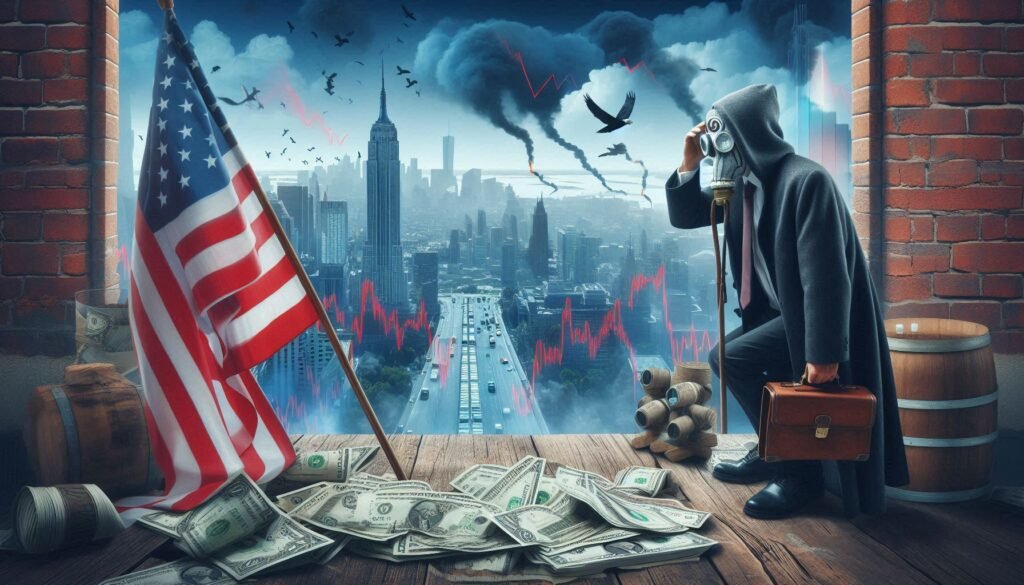
The landscape of the US economy has always been a subject of fluctuating narratives. From the buoyant assurances of steady growth to the grim forecasts of impending downturns, it’s a topic that never fails to capture attention. As we navigate the uncertain terrains of 2023, the conversation about recession risks is becoming increasingly pertinent. What do the indicators tell us? And how should businesses and consumers brace for what’s to come?
A Complex Web of Indicators
The US economy is a confluence of various moving parts, each playing a crucial role in shaping the overall fiscal health of the country. From employment rates to consumer spending and corporate earnings, many factors add layers of complexity to the economic narrative.
Consumer Spending: A Bellwether?
Consumer spending accounts for approximately 70% of the US GDP, making it a vital cog in the economic machine. Recent reports have shown a mixed bag of data. While certain sectors like retail have displayed robust growth, others like travel and hospitality remain less optimistic.
- Retail: A surge in online shopping and a return to in-person shopping have buoyed retail sales.
- Travel and Hospitality: Despite improvements, these sectors are yet to reach their pre-pandemic vibrancy.
Employment Rates: The Mixed Picture
The employment landscape offers another layer of complexity. Unemployment rates have improved since the pandemic, but labor force participation is still below optimal levels. Additionally, there’s an ongoing debate on the impact of automation and outsourcing on job security.
- Unemployment: Gradual recovery but pockets of high unemployment persist.
- Labor Force Participation: At a low, signaling potential untapped labor resources.
Monetary Policies: A Double-Edged Sword
The Federal Reserve’s policies have significant implications for the economy. While interest rate adjustments aim to curb inflation or stimulate growth, they also come with risks.
Interest Rates: Walking a Tightrope
Low-interest rates are a double-edged sword. On one hand, they encourage borrowing and investment; on the other, they risk inflating asset bubbles and increasing debt levels.
- Borrowing: More accessible for businesses and consumers.
- Debt Levels: A potential concern as businesses and households leverage up.
Inflation: The Rising Pressure
Inflation is both a sign of a recovering economy and a potential harbinger of economic trouble. Rising prices can erode purchasing power, affecting the standard of living for many.
- Consumer Prices: A steady rise causing a rethink on spending habits.
- Corporate Costs: Increasing operational costs for businesses.

Global Influences: The External Factors
The US economy doesn’t operate in isolation. Global events and dynamics exert substantial influence. Be it trade policies, geopolitical tensions, or international market trends, external factors are critical in shaping the economic landscape.
Trade Policies: The Balancing Act
Recent trade policies have seen a mix of protectionism and globalization, impacting various industries differently.
- Tariffs: Affecting import costs and consumer prices.
- Trade Agreements: Facilitating or hindering cross-border business operations.
Geopolitical Tensions: The Uncertain Waters
Geopolitical tensions, such as conflicts or diplomatic disputes, can have far-reaching economic impacts. The uncertainty can lead to market volatility, affecting investment and consumer confidence.
- Market Volatility: Increased fluctuations in stock markets.
- Investment Hesitation: Businesses and investors may adopt a wait-and-see approach.
Corporate Earnings: The Profit Perspective
Corporate earnings give a sneak peek into the health of the economy. They reflect consumer sentiment, spending habits, and overall business environment. Recent reports indicate a mixed outlook, with some sectors thriving while others struggle.
Thriving Sectors
Certain sectors have demonstrated resilience and adaptability. Technology, healthcare, and real estate, for instance, continue to show robust growth.
- Technology: Accelerated growth due to digital transformation.
- Healthcare: Increased demand for medical services and products.
- Real Estate: Boom in residential real estate, although commercial remains uncertain.
Struggling Sectors
On the flip side, other sectors face significant challenges. Energy, traditional retail, and automotive industries are under pressure due to various factors, including external competition and changing consumer behaviors.
- Energy: Transition to renewable resources is creating market turbulence.
- Traditional Retail: Struggling against the convenience of online shopping.
- Automotive: Facing supply chain disruptions and a shift towards electric vehicles.

Entering 2024: The Road Ahead
As we near the end of 2023, all eyes are on the coming year. Predictions range from optimistic growth to cautious pessimism. Several key factors will be instrumental in determining the economic trajectory:
Policy Changes
Government policies, both fiscal and monetary, will have a significant impact. Measures to control inflation, support employment, and stimulate economic activities will be closely watched.
- Fiscal Policies: Tax reforms and public spending plans.
- Monetary Policies: Federal Reserve’s stance on interest rates and bond purchases.
Technological Advancements
Technology will continue to be a crucial driver of economic growth. Innovations in AI, renewable energy, and biotechnology can open new avenues for investment and job creation.
- AI and Automation: Transforming various industries, increasing productivity.
- Renewable Energy: Driving the shift away from fossil fuels.
- Biotechnology: Leading breakthroughs in healthcare and pharmaceuticals.
Consumer Confidence
Consumer confidence will play a pivotal role. How comfortable people feel about their financial future will directly impact spending and saving habits.
- Job Security: A key determinant of consumer confidence.
- Income Stability: Influences spending on big-ticket items and leisure activities.
Wrapping it Up!
The US economy stands at a critical juncture. While certain indicators suggest stability, others raise concerns about the risks of a potential recession. Businesses, policymakers, and consumers must navigate this complex landscape with informed strategies and cautious optimism. Staying updated with economic trends and being agile in response to changes will be crucial as we move forward into uncertain times.
Like what I do? And want to help support? Click some of the amazon affiliate links and if you buy anything ,even if its not the products on the link, it costs you nothing extra and gives me a few cents. Every little bit helps in this economy!
You can also checkout a couple of my books


- Or any of my Coloring books Heres a comprehensive List of my Books on Amazon
